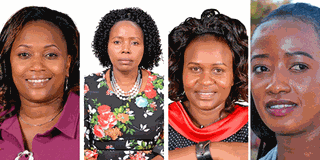Premium
Parties to call up 559 women to fill assemblies gender gap

From left: MCA- elects Evelyn Ndunge, Elizabeth Kawembe, Judith Wanza and Grace Bahati. These women beat all odds to win in male-dominated political derbies in the Ukambani region.
Parties will have to nominate 559 female ward representatives to the 47 county assemblies to meet the two-thirds gender rule after only 100 women were elected as legislators in the devolved units out of the 1,445 seats available.
The number of elected female ward representatives in the August 9 elections represents a marginal increase from the 97 who got in through the ballot in 2017.
In that election, 559 female members were nominated as gender top-up to meet requirements of Article 177 of the Constitution, which stipulates that the special seats will be picked as necessary to ensure that not more than two-thirds of any assembly is of one gender.
Another 90 female members will be nominated to represent marginalised groups.
The 2017 gender top-up was a drop from the 680 women nominated in the 2013 General Election, in which 84 female MCAs were elected to regional Houses.
The number of female MCAs could, however, increase as five wards are yet to elect their representatives after elections in the areas were postponed by the Independent Electoral and Boundaries Commission.
Kwa Njenga Ward in Embakasi South and Nyaki West had their elections last Monday with male candidates clinching the seats.
In this year’s elections, 10 counties—Lamu, Mandera, Garissa, Wajir, Marsabit, West Pokot, Samburu, Kajiado, Narok and Nyamira—did not elect a single woman to the regional legislatures.
In the 2017 elections, Embu, Garissa, Isiolo, Kajiado, Kirinyaga, Mandera, Narok, Samburu, Wajir and West Pokot were the culprits.
On the flip side, Nakuru County has the highest number of female MCAs standing at eight, followed by Bungoma, Kiambu, Kisumu and Homa Bay counties with six each.
Murang’a County has five female ward representatives while Kilifi, Trans Nzoia, Siaya, Nyeri and Nairobi have four each.
Nandi, Baringo, Mombasa, Vihiga, Migori and Tana River have three women MCAs each.
Voters in Embu, Machakos, Uasin Gishu, Bomet, and Laikipia counties elected two women to each of those assemblies. Taita Taveta, Kwale, Isiolo, Meru, Tharaka Nithi, Kitui, Makueni, Nyandarua, Kirinyaga, Kakamega, Turkana, Kericho, Elgeyo Marakwet, Busia and Kisii have a single female MCA each.
In 2017, Nairobi assembly led with the most nominated women at 34, as Kiambu, Kakamega, Kisii and Meru followed with 28, 25, 20 and 19, respectively.
Kilifi and Garissa each got 15 nominated women members.
The 10 assemblies that have no representation of a female MCA have to nominate at least 10 women to meet the legal threshold. The Constitution stipulates that the nomination slots will be as many as are required to ensure that no gender has more than two-thirds of the representation in the regional assemblies.




